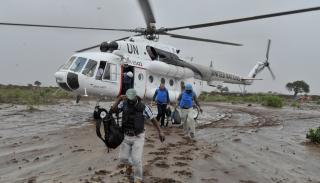
Breadcrumbs navigation
Militarisation in UN peace operations
In this article Dr Alexander Gilder discusses his research on how robust peacekeeping practices have impacted the relationships between the UN and its partners. Alexander received a BISA Early Career Small Research Grant for the project.
The UN has undertaken missions that are more robust than ever before, particularly in Mali (MINUSMA), DRC (MONUSCO), CAR (MINUSCA), and Haiti (MINUSTAH), following years of calls for greater peacekeeping capabilities. The push for robustness has led to peacekeepers being given greater military capabilities and equipment that allow for greater force generation in the field to protect civilians from imminent harm. Simultaneously, the protection of civilians and wider peacebuilding activities have seen the UN deploy alongside and collaborate with many external actors. The partnerships needed for a peacekeeping mission to be deployed and achieve its mandate are diverse and multifaceted. For instance, the UN Security Council must work with potential troop-contributing countries and the host state. UN peacekeepers then work alongside other UN funds, programmes and agencies, international NGOs and local civil society, and the host state to implement their mandate. How then have robust peacekeeping practices impacted the relationships between the UN and its partners? The project first mapped the trend of robustness by examining the increasing capabilities of peacekeepers and the drivers of militarisation. Then the project unpacked the complex relationships by conducting semi-structured interviews with participants ranging from UN personnel across various departments, agencies and programmes, member state permanent missions, military personnel from troop-contributing countries, and those working alongside peacekeepers in the field such as NGOs. The interviews unpack the evolution of partnerships amidst robust peacekeeping practices and allowed the project to suggest how peace operations can ensure positive working relationships with their partners.
One definition of militarisation is the “intensification of the labour and resources allocated to military purposes, including the shaping of other institutions in synchrony with military goals”. The UN has increasingly devoted more and more resources to strengthening the military capabilities of its peacekeepers. For instance, in Mali, MINUSMA has included intelligence and reconnaissance units from the Netherlands, Sweden, Germany, and Norway. MINUSMA has also utilised Chinook and Apache helicopters and C-130 transport aeroplanes which markedly increased the combat readiness of the mission. Part of this militarisation is the result of NATO countries reengaging with UN peace operations. NATO requires its members to be able to provide medical assistance and also use certain standards in relation to information management and intelligence classification. We have seen the expectations placed on UN peace operations grow further with the solution to instability seen as “more army, and more arms to the army.” African representatives and officials have argued the recent increases in militarisation are both necessary and justified and is a precondition to providing adequate human protection.
Militarisation has increased alongside mandates for UN peace operations to use ‘robust’ force. ‘Robust’ actions toe a fine line between peacekeeping and peace enforcement, a key distinction for the unique nature of UN missions that historically avoid enforcement action. MINUSMA, MINUSCA, and the mission in South Sudan (UNMISS) have not typically been described as enforcement missions. The UN does not regard robust mandates as authorising peacekeepers to take the initiative in the use of force which would denote a move away from the traditional requirement to only use force in self-defence. The missions all share hallmarks in their mandates including provisions to extend state authority and stabilise population centres, to adopt a ‘robust posture’, conduct active patrolling to deter armed groups, and allow space for the restoration of state authorities. Nevertheless, what impact has this change in posture and more militarized capabilities had on the mission’s working relationships and partnerships with other actors?
UN peacekeeping missions necessarily work closely with numerous actors in the field including, other UN funds, agencies and programmes (e.g. UNICEF, UN Women, UNDP, WFP), international NGOs providing humanitarian assistance, local NGOs and civil society, and the host state (both civil and military elements). To understand the impact recent mandates and practices have had on the relationship between peacekeepers and their partners in the field, the project undertook 31 semi-structured interviews with a range of personnel across UN missions (both civilian and military personnel), other UN funds, agencies and programmes, INGOs and civil society. Interviewees were asked in what capacity they worked with a UN peacekeeping mission, what worked well and what were the straining factors in those working relationships, where do we usually see cooperation between the mission and other actors, and to share their thoughts on the impact of changes such as the use of robust force, integration of specialised Western units, and whether robustness has helped support their organisation’s goals.
Initial analysis of the data has revealed several trends amongst the participants. Those working for other UN funds, agencies and programmes were more willing to seek force protection from UN peacekeepers compared to INGO participants, despite the traditional friction between the so-called blue and black UN. There was a clear recognition that uniformed peacekeepers may be the only way to access territory and that a robust posture can be beneficial in this regard. However, it was noted that donors often play an influential role and many UN agencies will work closely with local NGOs who may be less trusting of uniformed personnel requiring the UN funds, agencies and programmes to actively consider the impact of peacekeepers operating in the same spaces.
There was an apparent disconnect between INGOs and the UN with many participants reporting it was common for there to be, at worst, some level of distrust or, at best, a lack of understanding of the differences between each organisation’s goals. Several interviewees reported that UN peacekeeping staff had little appreciation for the importance of distance for the safety of INGO personnel. In contrast, all UN personnel interviewed fully appreciated the need for INGOs to maintain their neutrality. Uniformed personnel reported that they would often be excluded from meetings with INGOs who were invited to the UN compound, despite being keen to work towards common goals on the protection of civilians and delivery of humanitarian assistance. One participant, a uniformed peacekeeper, expressed frustration with the lack of open communication between INGOs and the UN mission. They explained that military contingents must plan for many eventualities in a dynamic conflict environment to achieve their mandate, but that it would not be unheard of for an INGO to request security assistance and the UN mission to have not known the INGO was visiting that area and consequently be unprepared to respond.
The disconnect between these actors led to many discussions about the personalities of individuals on each side and leadership which can shape these interactions. These factors were seen as key to fruitful, transparent relationships. Whereas specific mandate terminology, for example, if a renewal were to add ‘robustness’, was largely seen to be unimportant in terms of shaping relationships between the UN mission and other actors. Similarly, responses were mixed on whether the militarisation of UN peacekeeping had impacted the working relationship between participants and the UN missions. Nevertheless, many participants were hopeful that their organisations could have more consistently positive relationships and find ways to work toward shared goals.
Image by United Nations, licensed under the Creative Commons Attribution-Share Alike 4.0 International license.


